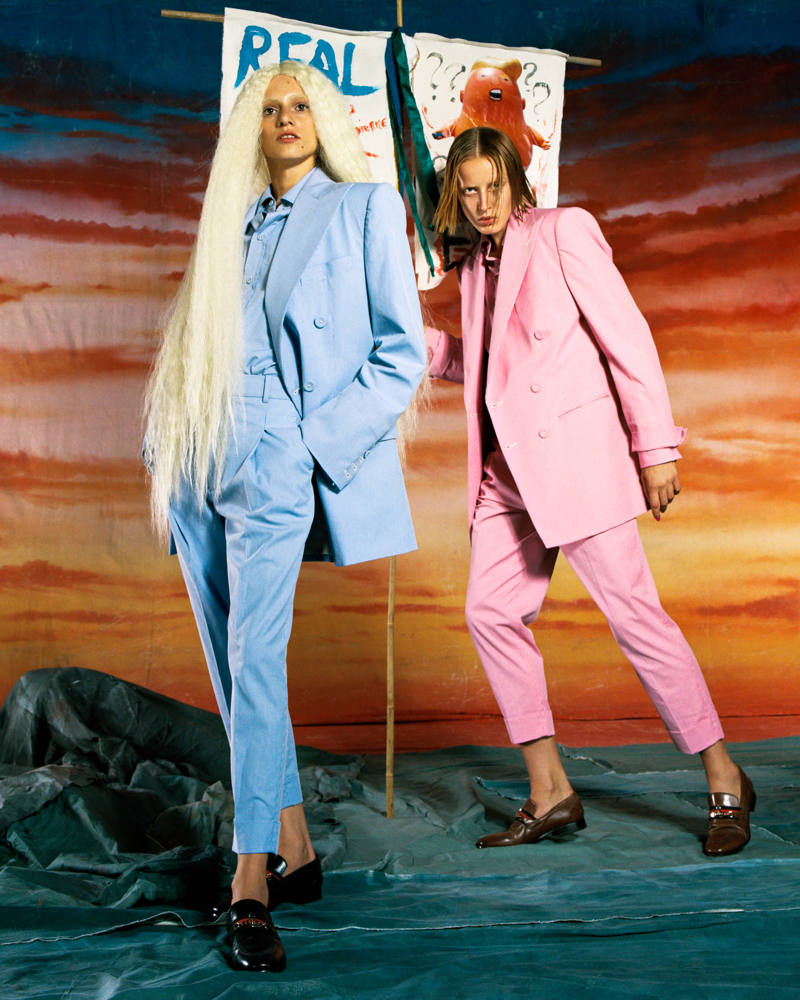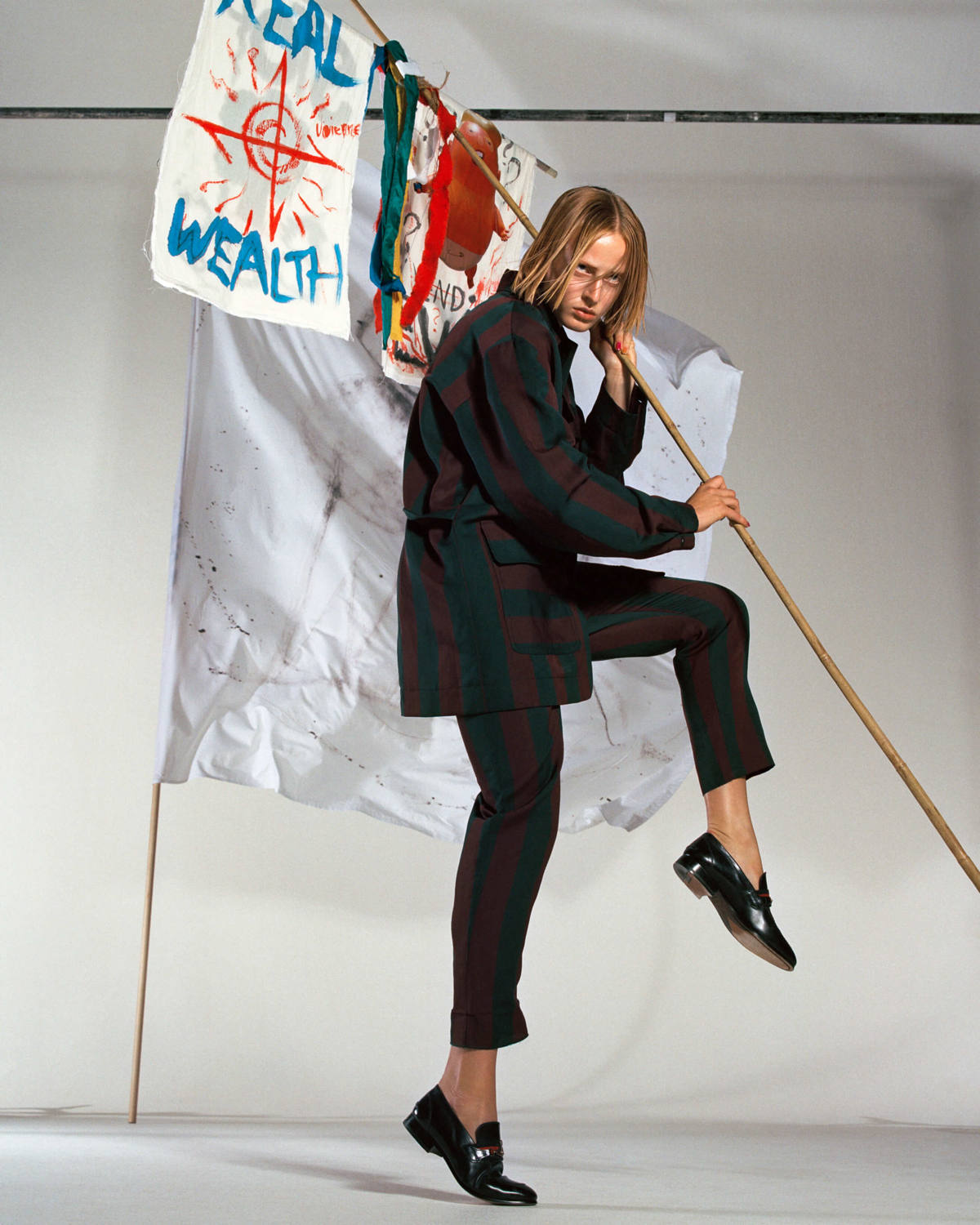
Vivienne Westwood, The First Political And Climate Change Luxury Brand
Vivienne Westwood is associated with sustainability and climate change for more than ten years now, even before sustainability was a topic found on every newspaper and television channel around the world. One of the most famous quotes connected to sustainable fashion is made by Vivienne – Buy less, choose well, make it last. Let’s see how much has she provide to a better sustainable luxury world.
There is no doubt that adopting a consumption model in which people choose their garments better and take good care for them would extend their life span. Ideally, this will lead to less extensive pressure on the fashion industry in terms of materials cultivation, production methods and endless buying. So by stating such a great statement dame, Vivienne inspires people all around the world to think more before inserting any new garment into their wardrobe. As a strong fashion designer, Vivienne Westwood is one of the last independent global luxury fashion houses, the same as Stella McCartney both campaigning for protecting life on mother earth, climate change and human rights.
Vivienne has been designing and making fashion for 50 years now, since 1970. In the beginning, it was punk style fashion, then softening into a more romantic style but all the time Vivienne used fashion to speak and share her social and environmental criticism. Since the beginning of 2000’s the brand’s aesthetic and story is also around putting historicism and relate to current events happening using a more asexual cut and patterns. Vivienne Westwood and, her just under 300 employees across the UK, use the brand’s voice to raise awareness to the environmental impact of overconsumption that is well associated with the fashion industry in the last three decades. They strive to make quality products that respect people and the planet focusing on four key areas; craft and heritage, people power, materials & processing and reimagining waste.
As part of preserving craft and heritage, Vivienne Westwood has been working with traditional British textiles and Savile Row tailoring traditions influenced the brand’s work since the 1980s. In recent years, artisans, as well as bigger Italian factories, are in collaboration with the brand. Today the brand still works with many small, highly skilled independent businesses. Some of the brand most iconic products that are recognised globally are signals of durable quality, style and high craftsmanship.



RESPONSIBLE EMPLOYER. ENVIRONMENTAL WARRIOR
Vivienne Westwood is aiming to be a responsible employer from providing desirable jobs and fair wages, developing it’s employees talents and skills and at the same time strengthening the voices of the workers emphasizing on vulnerable groups. The company is looking for collaborators and partners that share the same values and take responsibility for the labour conditions under which the company’s products are manufactured. The company and all its suppliers are insuring to work according to the conventions of the International Labour Organisation (ILO) and Modern Slavery Policy. As part of the Modern Slavery Statement of the company, they are ensuring slavery and human trafficking is not part of their supply chain and business. Vivienne Westwood is a member of Sedex, a collaborative platform for sharing responsible sourcing data on supply chains. According to the company, this membership helps them to gain control and manage the performance around labour standards and supply chain monitoring, health & safety and the environment.
In terms of materials and processes, the company is committed to sourcing raw materials with minimal social and environmental impact. The company aims to work mainly with mono-materials and each collection to reduce the blended fibres used since they are difficult to recycle to high-value fibres. The company uses a few certifications like Global Organic Textile Standard (GOTS), Oeko-Tex 100 and FSC (Forestry Stewardship Council). 96% of the cotton jersey used is currently made from certified organic yarns. Besides organic cotton jersey, the company is committed to using certified organic cotton yarns in 80% of their products during this year. An increase in the usage of fabrics such as hemp, which naturally reduce pests, controls erosion of topsoil, produces oxygen and uses less water in cultivation. Currently, 50% of their wool is from non-mulesed sources. The company is aiming to increase this to 75% by 2020 and 100% by 2021 and mainly source virgin wool fibres from farms certified with the Responsible Wool Standard. The company is reducing the use of polyester and acrylic fabrics, opting for natural or recycled alternatives like recycled polyester. The brand is part of the Canopy Style Initiative (ensuring no fabrics made from dissolving wood pulp are sourced from ancient and endangered forest areas) and has committed to only using FSC certified viscose by 2021.
The company prefers low impact dyeing and finishing techniques for textiles and use GOTS certified dyeing and processing where possible, for example in their silk supply chain. The rest of the products are dyed and processed in compliance with REACH which guides the company’s production in regards to Restricted Substances in these processes. Besides cotton, the company is researching into material innovation and sourcing Coir (coconut fibre), Nettle, Lenzing, Modal and Tencel. In 2018, the company initiated a chemicals improvement process in collaboration with Greenpeace Detox supporter, Texmoda Tessuti who are taking measures to eliminate all the hazardous substances from production by 2020. This wasn’t the brand’s first collaboration with Greenpeace- In 2013 a Save The Arctic campaign took over London Waterloo underground station. The campaign and exhibition showcased 60 black and white portraits of celebrities shot by Andy Gotts. All of them wore a Vivienne Westwood Save The Arctic organic unbleached cotton t-shirt to raise awareness and collect funds for Greenpeace.
The brand puts emphasis on animal welfare and base their work on international principles for sourcing materials derived from animals. The internationally recognised principles are the ‘Five Freedoms’ for animal welfare principles- freedom from hunger and thirst, constant access to freshwater and a healthy diet; Providing an appropriate living environment including shelter and a comfortable resting area; Freedom from pain, injury or disease, by prevention or rapid diagnosis and treatment; An obligation to express normal behaviour, by providing sufficient space and company; Liberation from fear and distress, avoiding mental suffering and providing treatment.
The company do not permit the use of exotic skins and fur in any of their products as well as any endangered species. In general the brand sources animal-based materials sustaining biodiverse ecosystems in areas where they source from legal sources. The whole supply chain of animal-based materials (including transportation of animals in the air, at sea and on land) should be undertaken with minimal environmental impacts, and in compliance with animal welfare, human and labour rights and environmental laws and regulations.
The brand only sources leather originating from cow, sheep, goat, pig and buffalo that is a by-product of the meat industry. Fish leather should be a by-product of the fish processing industry and originate from sustainably farmed sources, and all leather preferably certified by a recognised Institution. Suppliers of Brazilian leather should provide assurances that hides used for the brand’s products are from cattle raised outside the Amazon Biome, since the brand doesn’t want to have any connection with deforestation issues in the Amazon rainforest. The brand does not use the leather of kangaroo origin and horse origin. The tanning process of the leather that is used by the company is increasingly processed using environmentally friendly dyeing and tanning techniques; chrome-free and vegetable-tanned.



REIMAGINING WASTE
All retail packaging is plastic-free, made from FSC certified card and paper, the retail bags are made from 40% recycled pulp, 25% leather by-product and is produced with 100% green energy. Elimination of all single-use plastic from transit packaging is implemented. Now the company is working to change their plastic hangers and polythene garment covers to more sustainable alternatives.
The last action area of the brand is reimagining waste. The brand is committed to tackling textile waste through the collections and aims to make the most of the resources that go into their products, reusing, recycling and reimagining as they go. The brand prevents waste at the design stage where possible, using low waste experimental pattern cutting. The company applied a waste hierarchical approach to unused resources; reducing, reusing, recycling and recovering waste products, diverting as much as possible from landfill. At the same time, the brand is consolidating their labels and reducing the size of the collection since this is a really quick way to reduce the brand’s impact and is easily connected to manufacturing. This is an on-going process that the aim is to complete this process by 2020. The brand really seeks out opportunities to reuse and upcycle leftover fabric, deadstock and discarded materials.
Their new Green Logistics Hub has full waste recycling and reclamation facilities. The brand has a line of accessories called Made in Africa that is made using recycled canvas, reused roadside banners, unused leather off-cuts, and recycled brass cast and shirting stock reused for linings. The brand is regularly creating items and collaboration around reusing textile leftovers like in 2018, they partnered with Italian social enterprise Project Quid, that creates employment opportunities for vulnerable women. Together they create a limited-edition accessories collection from leftover silk stock. The design and production of the World’s End Collection- a unisex limited edition pieces range, was around the re-use of leftover production fabric from previous seasons.
SUPPORTING SUSTAINABLE TOPICS
Vivienne as a personality and her brand behind her supporting and engaged in many causes around sustainable topics. From Cool Earth focusing on saving the rainforest and stop Climate Change, up to inaugurate the ‘Climate Revolution’ at the London Paralympics closing ceremony in 2012. Vivienne campaigned and fundraised money for many organizations over the years like Environmental Justice Foundation, Friends of the Earth, Amnesty International and War Child, amongst many more. As you read the brand has collaborated and dedicated shows and products to raise money and awareness around some of these causes.
In collaboration with The British Fashion Council and the Mayor of London, the brand created a campaign called Fashion SWITCH. Reaching out to fashion businesses commiting to switching to a green energy supplier or to green energy by 2020. Hopefully, this would set an example for a global environmental change, since big brands like Christopher Raeburn, Harvey Nichols, Kering, Marks & Spencer, Oliver Spencer, Positive Luxury, Selfridges, Stella McCartney, Steventai & Teatum Jones are already part of this program. According to Julie’s Bicycle, a global charity that supports the cultural and creative community to act on Climate Change, they measured the impact of the actions taken by the brands that signed up to the campaign. Results from the first year (2017 – 2018) estimate a total of 125 tonnes of CO2 emissions avoided as a result of this industry shift.
SUPPORTING DIVERSITY AND GENDER EQUALITY
The last area in which Vivienne Westwood’s brand is emphasising on is supporting diversity in all its forms and gender equality in the workplace. Today, women at Vivienne Westwood account for 63% of the total headcount, and a big jump especially in leadership roles in recent years. The brand accumulated a report on gender pay gap from 2018 follows the methodology set out by the UK government. Based on the collected data the company outlined actions they are taking since to improve the diversity performances of the company.
Although the brand Vivienne Westwood seemed to have sustainability in the core of the business, as a persona Vivienne faces criticism from eco-activists who claim that despite her calls to save the environment she herself makes no concessions to making her clothing or her business more eco-friendly at the same level as she preaches in media and definitely at her fashion shows.








